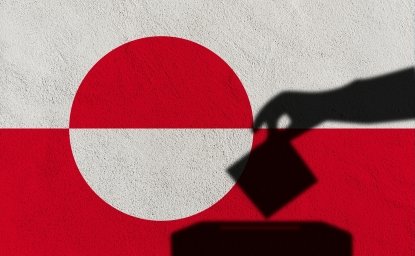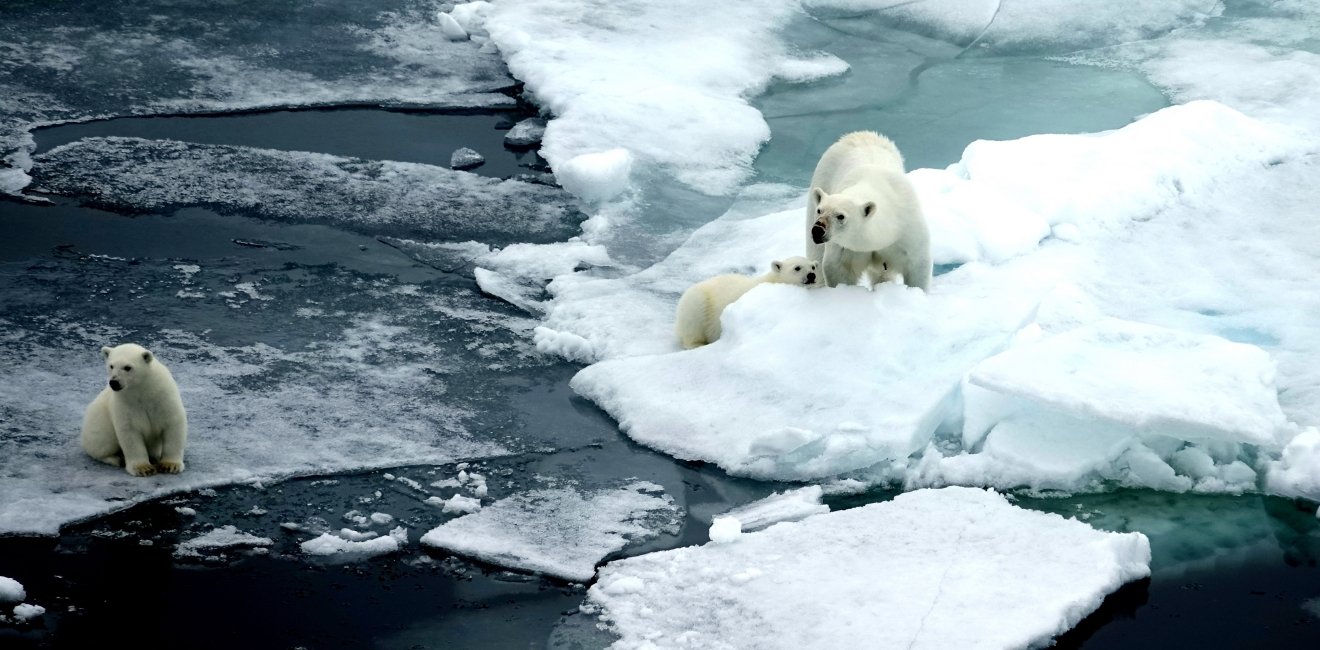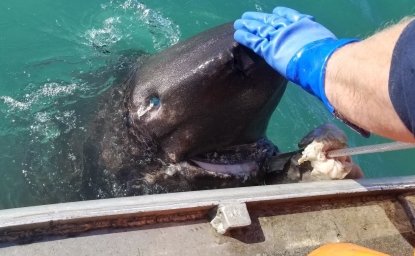
A blog of the Polar Institute
On a freezing summer day, I encountered the most majestic beasts of the Arctic during a trip to the North Pole. A mother and her two wee cubs, probably just a few months old, sauntered from the distant icescape toward my ship. Polar bears can reportedly smell seals—their main diet, partly for the fat layers that let them endure excruciating cold in the winter months—up to 20 miles away. The experts onboard suggested that the mother might have caught a whiff drifting from the kitchens of our ship.
The three bears were in no hurry, but also showed no hesitation. They stopped on the other side of an ice sheet that my ship had neatly sliced through. They lingered and looked up at the passengers and crew who, in turn, crowded the deck like kindergarteners to look back in wonderment. The two cubs wandered daringly away from their mother to explore thinner ice. They eventually returned to a family huddle and played with each other under her watchful gaze. After a while, she seemed to lose interest—or foresee benefits—and led her cubs, single-file, back into the distant ice.
Polar bears are the Arctic’s primary and largest predators. In the northern Svalbard archipelago, the gateway to Arctic voyages, laws require that anyone wandering beyond town limits carry weapons. I took a photo under a sign with a picture of a polar bear, in a red warning triangle, that declared, “Do not walk beyond this sign without firearm.” When we later left the ship to walk the Arctic floes or explore in zodiacs, half of the expedition leaders carried rifles, for which they had to be certified, in case of encounters with the bears. I often felt guilty. Humans are intruding on—and denigrating—their space, rather than the other way around.
One lingering lesson from my Arctic adventure was that polar bears are a microcosm of the challenges to the physics of our planet. The bears roam, hunt, sleep, mate and “den” (when females hide for months to give birth and nurse their vulnerable cubs) on sea ice. They are good swimmers too—reportedly able to paddle up to six miles an hour as adults, using their hind legs as rudders. But sea ice is their habitat. As it’s decreasing, so are bears in several of the 19 subpopulations in the five countries where they live—the US, Canada, Norway, Russia, and Greenland/Denmark.
In 2008, polar bears were the first species to be listed as “threatened” due to climate warming by the US Endangered Species Act. The threat has accelerated quickly. In 2020, another study warned that the ice-age animals could become extinct in all but one of the populations by the end of the century—just 75 years—if global warming continued apace. And in June 2024, a third study suggested that polar bears in the Hudson Bay region of Canada could become extinct in the 2030s, as sea ice is already down to a mere 150 days a year.
Today, the Arctic is heating up twice as fast as the rest of the planet, according to the World Wildlife Fund. It continues to shrink—having already lost an area of sea-ice cover larger than the size of Alaska and California combined. Global warming “is literally melting the sea-ice underneath the paws of the polar bear,” Morten Jorgensen, one of the experts on the expedition, wrote in “Polar Bears: Beloved and Betrayed.” “Arctic ecosystems are shifting and disappearing at a rate that contradicts evolution.”
I witnessed the impact across the Arctic in every encounter with polar bears. They were always wandering amid dozens of “melting ponds” on the horizon. As sea ice disappears, polar bears are increasingly forced on land, where they have less access to seals and sustenance. That ripples across all aspects of their lives, including how much fat they can store to survive, especially a mother while she retreats to a den. Less food can mean more fasting, weight loss, and not enough fat storage to give birth and nurture cubs with her milk. The very life cycle of polar bears is now threatened.
One of the quirks of polar bears is that they usually mate in the late spring, when males track females on the sea ice from the scented trails left by her footpads. Over the summer, the female serves as a kind of incubator for the fertile eggs as she hunts to ensure she has enough fat to breed, according to Polar Bears International. They’re called “mothers-in-waiting” by the National Wildlife Federation. The eggs then implant in her body in the fall. She dens in the winter to give birth. Seals, otters, kangaroos, and red pandas can also delay pregnancy as an adaptive advantage.
The plight of polar bears proves the impact of greenhouse gases. “We can’t build a fence around the polar bear’s melting habitat, and we can’t assign wildlife officers to guard the gate,” Polar Bears International has reported. “The key to getting the climate back to functioning the way it should is to transition away from fossil fuels for energy altogether.” Other factors in the 21st century have contributed. Militarization of the Arctic, exploration and drilling for minerals, and shipping across the Arctic have produced more pollution, Jorgensen noted.
The second lesson I learned is that laws to protect a threatened species simply don’t. During the first half of the 20th century, polar bear hunting was a popular trophy sport. The Soviet Union was the first country, in 1957, to ban it. In 1973, the Agreement on Conservation of Polar Bears acknowledged that overhunting threatened the species. It was signed by the U.S., Canada, Norway, Greenland/Denmark and the Soviet Union, the five countries with polar bear populations. Norway banned polar bear hunting altogether.
But the agreement had exceptions that opened the way for abuse. Polar bears could still be hunted, killed or captured by indigenous people “using traditional methods in the exercise of their traditional rights.” The exception technically covered the disparate Inuit communities in Alaska, Canada, and Greenland/Denmark; it introduced quotas for killing bears. Both have been exploited by foreign trophy hunters and traders in polar bear body parts, including the glistening fur. Hunters don’t use “traditional methods” once employed by nomads. They use high-powered rifles, GPS tracking, and snowmobiles. None of the hunting has been to support local subsistence, since the majority of Inuit are no longer nomads, Jorgensen said. “The claim that polar bear protection is working is a hoax.” Humans are now the predators in Arctic areas.
Since the 1973 agreement, at least 45,000 polar bears have been killed under the exemptions—roughly 1,000 a year, he estimated. A basic problem is that no government or scientific organization knows the real number of polar bears roaming sea ice that spans borders and continents. Guestimates range from 20,000 to 30,000. So, hunting quotas are based on “vague, fluid, outdated and uncertain” estimates that have evolved into “politically and commercially motivated licenses to kill,” Jorgensen said. Canada is the worst offender. Roughly two-thirds of polar bear subpopulations are in Canada. And two-thirds of polar bear kills—all legally sanctioned in a virtual industry—are in Canada.
One day, the expedition changed course to track polar bears. We found males, some of whom stood on their hind legs, towering ten feet high on the ice. Standing can signal an interest in play or just provide a better way to see and smell something a bear can’t identify. During dinner one evening, the captain came on the intercom to point out a mother and her two cubs also dining off the starboard side of the ship. The mother and one of her cubs were pulling on opposite ends on the ribcage of a seal carcass. On the expedition, we tracked 16 polar bears.
The Arctic provides a wondrous perspective of Earth—its physical history, its inhabitants, and its vulnerabilities. On one zodiac outing, an expedition scientist pointed out ground that had never been seen by humans before because it had been covered by a glacier since before our species evolved. Another day, a glaciologist pointed out a massive iceberg – the size of a city block with skyscrapers – that had broken off just two days earlier. At the North Pole itself, I navigated with poles to reach the so-called Blue Lagoon, a shimmering aqua melting pond the size of a small lake in what was supposed to be one of the coldest places on the planet. I could sense the changes ahead—for polar bears as well as the human species.
Author


Polar Institute
Since its inception in 2017, the Polar Institute has become a premier forum for discussion and policy analysis of Arctic and Antarctic issues, and is known in Washington, DC and elsewhere as the Arctic Public Square. The Institute holistically studies the central policy issues facing these regions—with an emphasis on Arctic governance, climate change, economic development, scientific research, security, and Indigenous communities—and communicates trusted analysis to policymakers and other stakeholders. Read more

Explore More in Polar Points
Browse Polar Points
In Search of Polar Bears in the Arctic Summer: Part II

Greenland’s New Governing Coalition Signals Consensus


